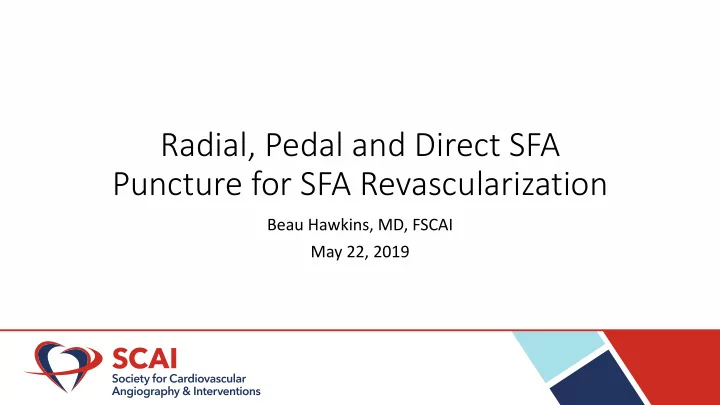

Radial, Pedal and Direct SFA Puncture for SFA Revascularization Beau Hawkins, MD, FSCAI May 22, 2019
Disclosures • None
Rationale for Alternative Access • Anatomical Needs • Lack of antegrade stump • Iliofemoral tortuosity • Procedural efficiency • Failure to cross or re-enter antegrade • Reduce complications Mustapha et al Interv Cardiol 2015;7:1-17
Transradial Approach- Important Distances Nakamura et al. Ind Heart J 2018;70:99-104
Transradial Approach • Familiar to coronary operators • Low bleeding risk • Pushability/torque limited • Limited equipment for complications (eg perforation) Korabathina et al. Vasc Heath Risk 2010;6:503-9
Retrograde Popliteal • Advantages • Disadvantages • Support/pushability • Prone positioning • Full armamentarium of tools • Hemostasis issues (stents, atherectomy) • Single access • Manual pressure versus balloon tamponade
Retrograde Popliteal- Complications Large AV - 68 year old male with RLE Fistula claudication - Prior RSFA Stenting for CLI (foot ulcer)
Retrograde Pedal RCFA occlusion Diffuse SFA • 60 yo female with LLE ischemic disease rest pain • Prior distal aorta/iliac stenting with high neo-carina 9 cm • Radials occluded, “no brachial SFA/pop lab” CTO • Plan- retrograde AT approach
Retrograde Pedal • Ultrasound-guidance 5/6 slender sheath • Retrograde crossing with hydrophilic .014’’ wire/.018 catheter
Retrograde Pedal • PTA/stent • Manual pressure x 20 min • Bedrest x 1hour
Retrograde Pedal- 38 yo female with rest pain, prior aortofemoral bypass Courtesy of M. Adu-Fadel
Retrograde Pedal
Retrograde Pedal
Retrograde Pedal
Retrograde Pedal- Practical Aspects • Ideal for simple SFA lesions and assists with learning curve • No antegrade access needed • Need adequate pre-procedure imaging (eg angiogram, duplex) • Anticoagulate well • Spasm is common- frequent vasodilators • Impact of tibial thrombosis is less clear • Caution needed in CLI patients with poor outflow
Where is Complex SFA Intervention Headed? Ruzsa et al. JACC Interv 2018;11:1062-71
Alternative Access Selection- Personal Preferences • Dynamic algorithm with annual modifications • Primary access: Pedal>radial • Primary pedal if approaching a simple, stenotic lesion • Primary femoral if complex, lengthy CTO or multilevel intervention planned • No brachial • No retrograde popliteal
Conclusions • Alternative access site use can improve procedural success • Procedural complexity and complication risk may be reduced with radial and/or pedal approaches • Increasingly complex lesions can be tackled via alternative access using proper patient selection and preparation
Recommend
More recommend